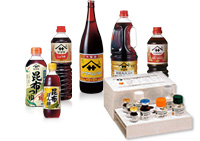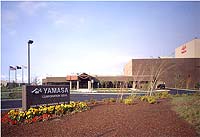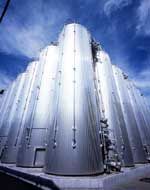 Contributing to the World of Medicine — Present Day —
Contributing to the World of Medicine — Present Day —



It was right at the height of the second world war when the 11th generation Hamaguchi Gihei took over from the 10th generation in 1943. After the hard times amid the post-war chaos and shortage of raw materials, Yamasa worked hard on pioneering new fields while at the same time protecting the quality of Yamasa Soy Sauce.
In 1983, the current president took over as the 12th generation Hamaguchi Gihei, and Yamasa Soy Sauce has developed as a manufacturer of integrated condiments and pharmaceuticals in addition to its soy sauce production, and on top of that, it has led to the development of a global enterprise to spread the taste of Japan to the world
![]()


In 1955, Akira Kuninaka of the Yamasa Research Institute, with his expansive experience and knowledge base on the microbes cultivated in brewing soy sauce, discovered that the flavorful “umami” component of katsuobushi (dried, fermented bonito tuna) was the 5′-inosinic acid among inosinic acids. He followed that up in 1957 by discovering a microbial enzyme that makes 5′-inosinic acid by breaking down the ribonucleic acid (RNA) of yeast. It was also found that the 5′-guanylic acid that can be made using the same enzyme is the flavorful umami component of shiitake mushrooms, and the company ultimately succeeded in industrially producing 5′-inosinic acid and 5′-guanylic acid. These umami components were found to have a “synergistic effect on taste” in which the umami taste is incredibly amplified by being mixed with monosodium glutamate — the umami component of dried kelp seaweed. With these discoveries, Akira Kuninaka was awarded the “Imperial Invention Award” in 1964.
Leveraging these discoveries, Yamasa began selling its composite umami seasoning “Yamasa Flave”, spreading a new flavor around the world. The umami flavor that had formerly only been obtained by experience was scientifically explained by Yamasa’s dedicated researcher, making a significant contribution to the culinary field.
![]()

Yamasa’s soy sauce technology which creates flavorful umami components by breaking down nucleic acids would lead to a technology that creates nucleic acid-related compounds which are important for life and vital activities. DNA and RNA, substances essential for life, are broken down into nucleotides using original enzymes and enzymatic reactions while chemical synthesis and biotechnology are also taken advantage of to send all kinds of nucleic acid-related compounds out into the world. Yamasa Soy Sauce’s nucleic acid-related compounds are used in a variety of fields, including as raw material for pharmaceuticals, food and nutrition enhancers, and diagnostic pharmaceuticals to diagnose illnesses. Now, the company’s nucleic acid-related compounds are constantly regarded as world-class in the field of nucleic acids for their supply capacity, production technology, and quality.
The diverse range of product development, which spread from soy sauce to pharmaceuticals, is a result born naturally out of Yamasa Soy Sauce’s efforts invested in microbe research. Yamasa Soy Sauce’s ventures in turning out products including food and medicine with the life force inherent in microbes can be considered the “life industry” in its own right.
![]()

The soy sauce made by Yamasa Soy Sauce prior to World War II was nothing but a regular “koikuchi” (thick taste) soy sauce. However, in association with the revival of the culinary culture and the improvements in life standards following the war, soy sauces that reflected the needs of the time were developed. To illustrate, there is the new genre of soy sauce, “Shinmi (‘new-flavor’) Soy Sauce”, which leverages the umami taste synergistic effect discovered by Yamasa, along with “Sashimi Soy Sauce” which combines the aromas of “koikuchi” thick-tasting soy sauce and with an umami flavor rivaling that of “tamari” (lightly salty) soy sauce. In 1992, Yamasa Soy Sauce was ahead of the industry in making a product of “Organic, Round Soybean, Carefully-Selected Soy Sauce”, which used organically cultivated soybeans in a time when securing organically cultivated raw materials and managing all parts of the manufacturing process together were a challenge.
It is not only soy sauce — in 1979 when people’s awareness for authentic and simple items picked up, Yamasa Soy Sauce released a straight “tsuyu” noodle sauce in the bottle that was said to be impossible in the industry. In 1997 when there were strong fixed sentiments that “katsuo dashi” (soup broth made from bonito tuna flakes) was the only way to go in the noodle tsuyu sauce market, Yamasa Soy Sauce succeeded in the commercialization of “kelp tsuyu” which was based mainly on dried kelp seaweed broth.
Not getting caught up in common thinking and stereotypes, Yamasa Soy Sauce has continued to create new products.
![]()


The Yamasa Factory in Oregon, U.S.A.
Soy sauce has supported Japanese culinary culture as a basic condiment for all types of cooking. Now, it is loved all over the world, not just in Japan.
Yamasa Soy Sauce completed its soy sauce factory in Oregon, U.S.A. in July, 1994. Currently, Yamasa Soy Sauce “Made in U.S.A.” is shipped out from this factory to America, Canada, Mexico, and other countries.
![]()


Yamasa Soy Sauce has obtained ISO 9001:2000 certification, an international standard for quality assurance, and is stepping up efforts day-in and day-out to build systems that enable product manufacturing allowing for peace of mind. In the fall of 2002, the company constructed a tank to brew a small quantity but diverse variety of soy sauce in order to respond to a wide range of needs and provide peace of mind. This tank features “super stainless steel” which is resistant to rust even after decades, and to top that off, it is sanitary since it is completely shut off from outside air. Also, since it does not release the alcohol produced while brewing the soy sauce, it enables environmentally-friendly product manufacturing.
At Yamasa Soy Sauce, we constantly strive for safe and secure product manufacturing while maintaining our quality.
![]()
![]()

It was right at the height of the second world war when the 11th generation Hamaguchi Gihei took over from the 10th generation in 1943. After the hard times amid the post-war chaos and shortage of raw materials, Yamasa worked hard on pioneering new fields while at the same time protecting the quality of Yamasa Soy Sauce.
In 1983, the current president took over as the 12th generation Hamaguchi Gihei, and Yamasa Soy Sauce has developed as a manufacturer of integrated condiments and pharmaceuticals in addition to its soy sauce production, and on top of that, it has led to the development of a global enterprise to spread the taste of Japan to the world
![]()
![]()
In 1955, Akira Kuninaka of the Yamasa Research Institute, with his expansive experience and knowledge base on the microbes cultivated in brewing soy sauce, discovered that the flavorful “umami” component of katsuobushi (dried, fermented bonito tuna) was the 5′-inosinic acid among inosinic acids. He followed that up in 1957 by discovering a microbial enzyme that makes 5′-inosinic acid by breaking down the ribonucleic acid (RNA) of yeast. It was also found that the 5′-guanylic acid that can be made using the same enzyme is the flavorful umami component of shiitake mushrooms, and the company ultimately succeeded in industrially producing 5′-inosinic acid and 5′-guanylic acid. These umami components were found to have a “synergistic effect on taste” in which the umami taste is incredibly amplified by being mixed with monosodium glutamate — the umami component of dried kelp seaweed. With these discoveries, Akira Kuninaka was awarded the “Imperial Invention Award” in 1964.
Leveraging these discoveries, Yamasa began selling its composite umami seasoning “Yamasa Flave”, spreading a new flavor around the world. The umami flavor that had formerly only been obtained by experience was scientifically explained by Yamasa’s dedicated researcher, making a significant contribution to the culinary field.
![]()

Yamasa’s soy sauce technology which creates flavorful umami components by breaking down nucleic acids would lead to a technology that creates nucleic acid-related compounds which are important for life and vital activities. DNA and RNA, substances essential for life, are broken down into nucleotides using original enzymes and enzymatic reactions while chemical synthesis and biotechnology are also taken advantage of to send all kinds of nucleic acid-related compounds out into the world. Yamasa Soy Sauce’s nucleic acid-related compounds are used in a variety of fields, including as raw material for pharmaceuticals, food and nutrition enhancers, and diagnostic pharmaceuticals to diagnose illnesses. Now, the company’s nucleic acid-related compounds are constantly regarded as world-class in the field of nucleic acids for their supply capacity, production technology, and quality.
The diverse range of product development, which spread from soy sauce to pharmaceuticals, is a result born naturally out of Yamasa Soy Sauce’s efforts invested in microbe research. Yamasa Soy Sauce’s ventures in turning out products including food and medicine with the life force inherent in microbes can be considered the “life industry” in its own right.
![]()
![]()
The soy sauce made by Yamasa Soy Sauce prior to World War II was nothing but a regular “koikuchi” (thick taste) soy sauce. However, in association with the revival of the culinary culture and the improvements in life standards following the war, soy sauces that reflected the needs of the time were developed. To illustrate, there is the new genre of soy sauce, “Shinmi (‘new-flavor’) Soy Sauce”, which leverages the umami taste synergistic effect discovered by Yamasa, along with “Sashimi Soy Sauce” which combines the aromas of “koikuchi” thick-tasting soy sauce and with an umami flavor rivaling that of “tamari” (lightly salty) soy sauce. In 1992, Yamasa Soy Sauce was ahead of the industry in making a product of “Organic, Round Soybean, Carefully-Selected Soy Sauce”, which used organically cultivated soybeans in a time when securing organically cultivated raw materials and managing all parts of the manufacturing process together were a challenge.
It is not only soy sauce — in 1979 when people’s awareness for authentic and simple items picked up, Yamasa Soy Sauce released a straight “tsuyu” noodle sauce in the bottle that was said to be impossible in the industry. In 1997 when there were strong fixed sentiments that “katsuo dashi” (soup broth made from bonito tuna flakes) was the only way to go in the noodle tsuyu sauce market, Yamasa Soy Sauce succeeded in the commercialization of “kelp tsuyu” which was based mainly on dried kelp seaweed broth.
Not getting caught up in common thinking and stereotypes, Yamasa Soy Sauce has continued to create new products.
![]()
 The Yamasa Factory in Oregon, U.S.A.
The Yamasa Factory in Oregon, U.S.A.
Soy sauce has supported Japanese culinary culture as a basic condiment for all types of cooking. Now, it is loved all over the world, not just in Japan.
Yamasa Soy Sauce completed its soy sauce factory in Oregon, U.S.A. in July, 1994. Currently, Yamasa Soy Sauce “Made in U.S.A.” is shipped out from this factory to America, Canada, Mexico, and other countries.
![]()


Yamasa Soy Sauce has obtained ISO 9001:2000 certification, an international standard for quality assurance, and is stepping up efforts day-in and day-out to build systems that enable product manufacturing allowing for peace of mind. In the fall of 2002, the company constructed a tank to brew a small quantity but diverse variety of soy sauce in order to respond to a wide range of needs and provide peace of mind. This tank features “super stainless steel” which is resistant to rust even after decades, and to top that off, it is sanitary since it is completely shut off from outside air. Also, since it does not release the alcohol produced while brewing the soy sauce, it enables environmentally-friendly product manufacturing.
At Yamasa Soy Sauce, we constantly strive for safe and secure product manufacturing while maintaining our quality.
![]()


 Go to top Yamasa History
Go to top Yamasa History